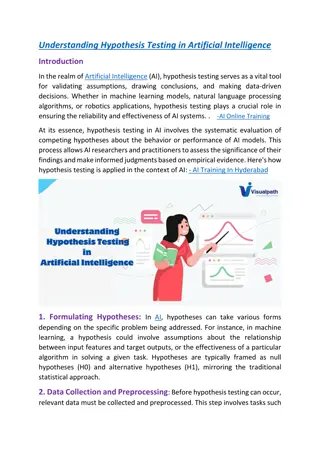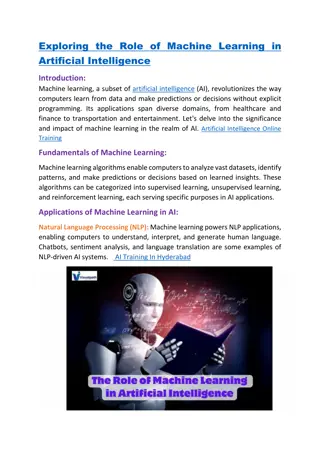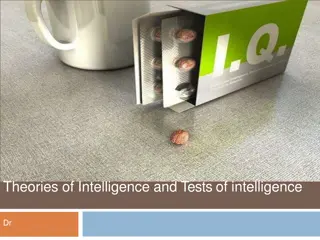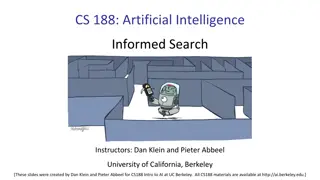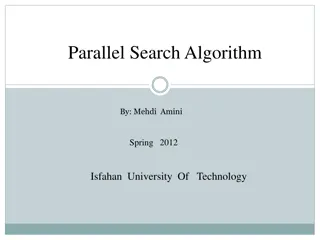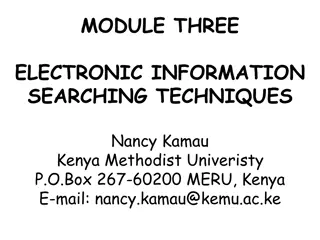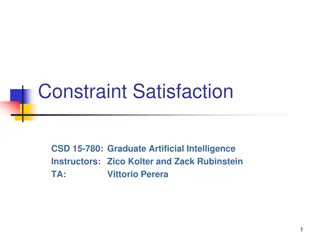Solving Problems by Searching in Artificial Intelligence: Uninformed Search Strategies
In the field of Artificial Intelligence, solving problems through searching is essential. Uninformed search strategies, also known as blind search, involve exploring the search space without any additional information beyond what is provided in the problem definition. Techniques such as Breadth-First Search, Uniform Cost Search, Depth-First Search, Depth Limited Search, Iterative Deepening Depth First Search, and Bidirectional Search are discussed in detail, highlighting their methodologies and performance characteristics.
- Artificial Intelligence
- Search Strategies
- Uninformed Search
- Problem Solving
- Artificial Intelligence Lecture
Download Presentation

Please find below an Image/Link to download the presentation.
The content on the website is provided AS IS for your information and personal use only. It may not be sold, licensed, or shared on other websites without obtaining consent from the author. Download presentation by click this link. If you encounter any issues during the download, it is possible that the publisher has removed the file from their server.
E N D
Presentation Transcript
College of Engineering & Technology Computer Techniques Engineering Department Artificial Intelligence Stage 3 Artificial Intelligence Artificial Intelligence Lecture 4 Solving Problems by Searching
Uninformed Search Strategies (Blind Search) Uninformed Search Strategies (Blind Search) The term blind means that the strategies have no additional information about states beyond that provided in the problem detention. All they can do is generate successors and distinguish a goal stat from non-goal state. All Search Strategies are Distinguished by the order in with nodes are expanded
Uninformed Search Strategies (Blind Search) Uninformed Search Strategies (Blind Search) 1. Breadth-First Search 2. Uniform Cost Search 3. Depth-First Search 4. Depth limited search 5. Iterative deepening depth first search. 6. Biodirectional search
1 1- - Breadth Breadth- -First Search First Search It is simple strategy in which root node is expanded first. Successors of the root are expanded next. Then their successors, and so on. All the nodes are expanded at a given depth in the search tree before and nodes at the next level are expanded.
Breadth Breadth- -First Search First Search
Breadth Breadth- -First Search First Search In breadth-first search algorithm the shallowest node is chosen for expansion. This is achieved very simply by using FIFO queue New nodes which are always deeper than their parent go to the back of the queue.
Breadth Breadth- -First Search Performance First Search Performance Breadth-first search is complete Breadth-first is optimal if the path cost is a nondecreasing function. TIME and MEMORY
Breadth Breadth- -First Search Performance First Search Performance TIME and MEMORY
Breadth Breadth- -First Search Examples First Search Examples
Breadth Breadth- -First Search Examples First Search Examples
Breadth Breadth- -First Search Examples First Search Examples Visited: S, A, B, D
2 2- -Uniform Uniform- -cost search cost search Breadth-first always expands the shallowest unexpanded node. Breadth-first is optimal because the step cost are equal. By a simple extension, we can find an algorithm that is optimal with any step-cost function. Uniform-cost search expands the node n with the lowest path cost g(n).
Uniform Uniform- -cost search cost search The figure explains the problem to get from Sibiu to Bucharest. The successors of Sibiu are Rimnicu Vilcea and Fagaras. With cost 80 and 99, respectively. The least cost nod Rmnicu Vilcea is expanded. Next, adding Pitest with cost 80+97 = 177. The least cost now is Fagaras (99 < 177) so it is expanded. Adding Bucharest with cost 99 + 211 = 310 A goal node has been generated, BUT THE ALGORITHM KEEP SEARCHING. Expanding Pitesti and adding a second path to Bucharest with a cost 80 + 97 + 101 = 278. The algorithm check the new path is better than the old one (cost 278 < 310) and the solution is returned
Uniform Uniform- -cost search cost search
Uniform Uniform- -cost search Example cost search Example
Uniform Uniform- -cost search Example cost search Example Visited: S, A, D, B, C, E
3 3- -Depth Depth- -first search first search It always expands the deepest node in the current frontier of the search tree. The search proceeds immediately to the deepest level of the search tree. If the node has no successors, it dropped frontier and the search backs up Depth first search uses LIFO queue. LIFO means that the most recently generated node is chosen for expansion.
Depth Depth- -first search first search
Depth Depth- -first search first search
Depth Depth- -first search first search
4 4- -Depth Depth- -limited search limited search To overcome the drawbacks of depth-first search The depth-first search is predetermined with depth L Nodes at depth L treated as if they have no successors This approach is called depth-limited search. This approach solve some problem , but also introduce an additional source of incompleteness. L can be specified based on previous knowledge of the problem.
5 5- -Iterative deepening depth Iterative deepening depth- -first search first search It is general strategy often used in combination with depth first search. It gradually increasing the limit, first 0, then 1, then 2 and so on. Until a goal is found. It combine the benefits of depth-first and breadth-first search. Like depth-first memory requirements are modest. Like breadth-first it is complete and optimal when path cost is a nondecreasing function.
5 5- -Iterative deepening depth Iterative deepening depth- -first search first search
6 6- -Bidirectional Search Bidirectional Search Run to simultaneous searches. One forward from the initial state. The other backward from the goal. Hoping the two searches meet in the middle. It implemented by replacing the goal test with a check to see whether the frontiers of the two searches intersect.
6 6- -Bidirectional Search Bidirectional Search
Thanks for Your Attention Thanks for Your Attention




